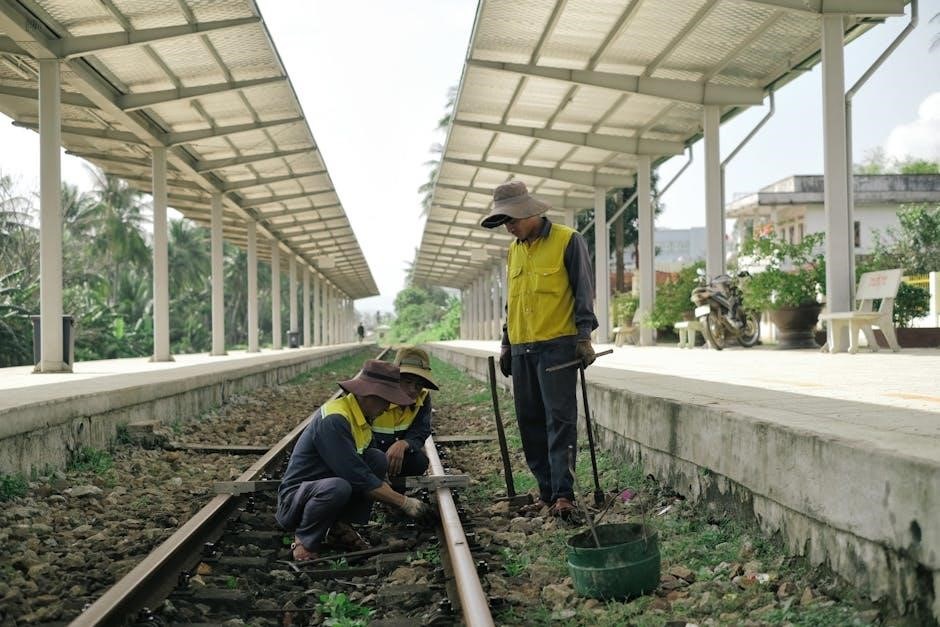manual alarm station

Manual alarm stations are essential devices in fire safety systems, typically mounted on walls, used to alert occupants of potential fires quickly always.
Definition and Purpose
A manual alarm station is a device designed to initiate fire alarm systems manually, typically consisting of a handle or lever that can be pulled down or pushed to trigger an alarm, its primary purpose is to quickly alert building occupants of a potential fire, allowing for prompt evacuation and minimizing damage, this device plays a crucial role in ensuring the safety of people and property in emergency situations, providing a reliable means of alerting others to a fire.

Components of a Manual Alarm Station
Manual alarm stations have various components including handles and levers always.
Design and Functionality
The design of manual alarm stations focuses on simplicity and ease of use, with a handle or lever that can be easily activated in emergency situations, typically by pulling it down, which then triggers the alarm, the functionality is straightforward, allowing for quick response to potential fires, the stations are usually designed to be durable and reliable, with a clear indication of their purpose, making them an essential component of fire safety systems, used to alert occupants and initiate evacuation procedures quickly and efficiently always in public buildings.
Types of Manual Alarm Stations
Manual alarm stations have single-action and dual-action mechanisms always available.
Single-Action and Dual-Action Mechanisms
Manual alarm stations have two main types of mechanisms, single-action and dual-action, which initiate the alarm signal. The single-action mechanism is simple, requiring only one action to trigger the alarm. In contrast, the dual-action mechanism requires two separate actions, providing an additional layer of safety to prevent false alarms. These mechanisms are designed to ensure that the alarm is only activated in genuine emergency situations, and they play a crucial role in the overall functionality of manual alarm stations, making them reliable and efficient in emergency situations always and effectively.
Importance of Manual Alarm Stations
Manual alarm stations play crucial role in emergency situations always saving lives quickly and effectively every time with great success always.
Role in Fire Safety Plan
Manual alarm stations are a vital component of a fire safety plan, providing a quick and effective way to alert occupants of a fire. They are strategically placed in locations where they can be easily accessed, allowing for rapid response in emergency situations. The role of manual alarm stations is to initiate the alarm system, which then alerts occupants and emergency services, enabling a swift evacuation and minimizing damage and risk to life and property, ensuring a safe and timely response always and effectively.

Activation of Manual Alarm Stations
Manual alarm stations are activated by pulling a handle or lever to initiate the alarm system quickly and easily always now.
Initiating the Alarm
Initiating the alarm is a critical step in ensuring the safety of occupants in a building. The manual alarm station is designed to be easy to use, with a simple pull or push mechanism to activate the alarm. When the alarm is initiated, it sends a signal to the fire alarm control panel, which then sounds the evacuation alarm. This prompt action helps to alert occupants of a potential fire, allowing them to evacuate the building quickly and safely, and it is an essential part of any fire safety plan always and everywhere.

Comparison with Automatic Fire Alarm Systems
Manual alarm stations differ from automatic systems in activation methods always requiring human intervention quickly and easily every time somewhere.
Convenience and Reliability
Manual alarm stations offer convenience and reliability in emergency situations, allowing for quick activation of alarms, they are easy to use and understand, providing a sense of security, their simple design makes them reliable and less prone to false alarms, ensuring that help arrives quickly, they are an essential component of fire safety systems, providing a manual backup to automatic systems, and are strategically placed in accessible locations, making them convenient to use in emergency situations every day always.
Placement of Manual Alarm Stations
Manual alarm stations are typically placed near exits and stairwells always easily.
Strategic Location
Manual alarm stations are placed in strategic locations to ensure quick access and visibility, typically near exits, stairwells, and corridors, allowing for easy activation in emergency situations, and are usually mounted between 42 and 54 inches above the floor to accommodate people with disabilities, and are also placed on every level of a building, including basements and mezzanines, to provide comprehensive coverage and enable rapid response to fires or other emergencies, and are an essential component of a building’s fire safety system.

Regulations and Standards
Manual alarm stations must comply with national fire codes and standards always perfectly.
Compliance with Fire Safety Regulations
Manual alarm stations must adhere to specific regulations, including those set by national fire protection associations. The installation and maintenance of these devices are crucial to ensuring compliance. Building owners and managers are responsible for adhering to these regulations, which include regular testing and inspection of manual alarm stations. Compliance with fire safety regulations is essential to prevent fines and penalties, and to ensure the safety of building occupants. Regulations vary by jurisdiction, but all require manual alarm stations to be installed and maintained properly at all times to ensure safety.
Maintenance and Testing
Regular maintenance and testing of manual alarm stations ensure proper functionality always and quickly.
Ensuring Proper Functionality
Manual alarm stations require regular inspections and tests to ensure they are working correctly. This involves checking the station’s mechanical parts, electrical connections, and alarm sounding devices. The testing process typically includes activating the station and verifying that the alarm sounds and the signal is transmitted to the fire alarm control panel. Additionally, any issues or defects found during testing must be addressed promptly to maintain the station’s reliability and effectiveness in emergency situations, thus ensuring public safety and compliance with regulations always and quickly every time.